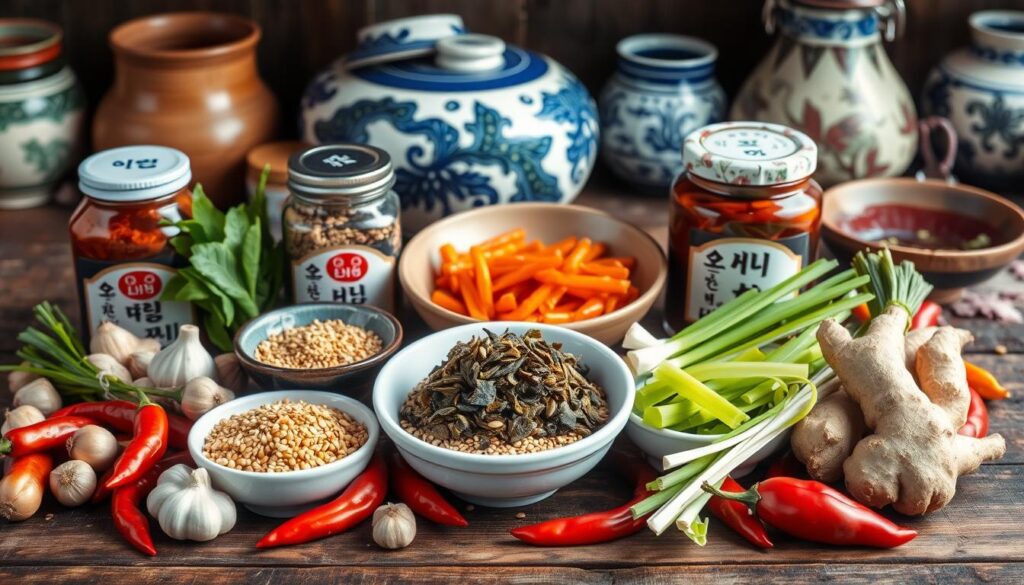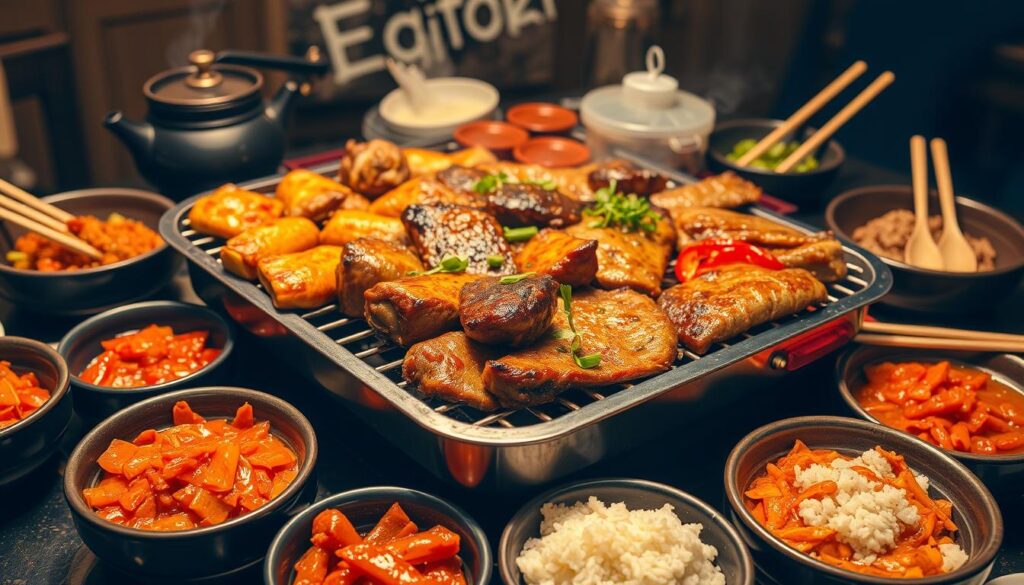Korean cuisine is a mix of bold flavors and deep cultural roots. From spicy kimchi to savory bulgogi, Korean dishes offer a unique taste adventure.
Korean food is a big part of daily life, often seen in K-dramas. These shows highlight Korea’s rich food traditions. Making these dishes at home is surprisingly simple. You just need a Korean pantry and a desire to try new flavors.
Table of Contents
Essential Korean Pantry Ingredients for Authentic Cooking
To make your Korean dishes authentic, start with a well-stocked pantry. At the core of Korean flavors are kimchi and gochujang (red chili paste). These ingredients add bold, umami tastes to many Korean dishes.
Key Fermented Ingredients and Seasonings
Kimchi is just the beginning. Don’t forget doenjang (soybean paste) and gochugaru (red chili flakes). They’re great for making marinades, sauces, and seasonings that add a traditional touch to your korean recipes.
Must-Have Sauces and Pastes
Soy sauce is key in Korean cooking. You’ll find different types like yangjo ganjang and hansik guk ganjang. Also, don’t overlook gochujang and doenjang. They add unique tastes to many korean recipes and fermented korean recipes.
Traditional Herbs and Aromatics
No Korean pantry is complete without garlic, ginger, and green onions. These ingredients are vital for creating deep, layered flavors. Adding them to your kimchi recipes can turn simple dishes into masterpieces.
With these essential Korean pantry items, you’ll open up a world of flavors. You’ll be well on your way to becoming a pro at korean recipes at home.

Popular Korean BBQ Recipes for Home Cooking
Bring the vibrant flavors of Korean cuisine to your kitchen with these delicious Korean BBQ recipes. Try the classic bulgogi (Korean marinated beef) and the beloved galbi (Korean short ribs). Learn the art of grilling and enjoy these traditional dishes.
Bulgogi: Korean Marinated Beef
Bulgogi is a favorite Korean BBQ dish. It’s thinly sliced beef marinated in a sweet and savory mix of soy sauce, brown sugar, garlic, and ginger. The beef becomes tender and caramelized, perfect for grilling. Enjoy it wrapped in lettuce or with steamed rice for a full Korean BBQ meal.
Galbi: Traditional Korean Short Ribs
Galbi, or Korean short ribs, is a must-try in Korean BBQ. These bone-in ribs are marinated in soy sauce, brown sugar, garlic, and aromatics. Grill them until charred and serve with Korean side dishes for a traditional BBQ spread.
BBQ Marinades and Dipping Sauces
The secret to great korean bbq recipes is in the marinade and dipping sauces. Korean BBQ marinades mix soy sauce, brown sugar, garlic, ginger, and sesame oil. This creates deep, complex flavors. Pair your grilled dishes with spicy gochujang sauce or a refreshing soy-vinegar dip for a memorable meal.

Start your Korean BBQ journey at home. With these recipes and techniques, you’ll master the art of korean bbq. Create unforgettable meals for your loved ones.
Mastering Kimchi and Fermented Korean Recipes
Kimchi is a key part of Korean food. It’s a fermented veggie dish used in many recipes. Learning to make kimchi can add lots of flavor to your cooking.
The Easy Kimchi (막김치) recipe is very popular. It has been watched 19,332,901 times on YouTube. People love it, giving it a 4.9/5 rating from 652 votes. The comments show how much people want to make it perfectly.
Making kimchi at home lets you adjust the flavors. You need napa cabbage, salt, and other ingredients. It takes just 35 minutes to prepare and 2 days to ferment. This way, you can enjoy its unique taste.
Fermentation is important in Korean cooking. It makes dishes more complex and flavorful. Trying different fermented Korean recipes can lead to exciting new tastes. You can make everything from kimchi stew to new fusion dishes.
Whether you’re new to Korean food or already love it, exploring kimchi and fermented recipes is exciting. With practice and a love for bold tastes, you can become a kimchi expert.
Classic Korean Rice Dishes and Bibimbap Variations
At the heart of Korean cuisine is bibimbap, a rice bowl dish loved by many. It combines warm white rice with seasoned vegetables, sautéed meat, and spicy gochujang sauce. This mix creates a perfect blend of tastes and textures.
Traditional Bibimbap Preparation
Bibimbap has been a part of Korean culture for centuries. It’s made by mixing cooked rice with various side dishes. The dish includes julienned vegetables like carrots and zucchini, along with sautéed bracken fern stems and a choice of protein.
Modern Rice Bowl Adaptations
Modern bibimbap shows the dish’s versatility. It now includes ingredients like Italian sausage, showing Korean cuisine’s growth. Rice dishes are key in Korean cooking, offering a base for creative flavors and personal touches.
“Bibimbap is a harmonious blend of warm rice, fresh vegetables, and savory proteins, all coming together in a delightful mix of textures and flavors.”
Bibimbap’s beauty is in its ability to be customized. Whether sticking to the classic recipe or trying new twists, it’s a journey through Korean flavors. It’s a fun way to explore and enjoy different tastes in a single dish.
Authentic Korean Soup and Stew Recipes
Korean soups and stews are perfect for cold weather. Kimchichigae is a spicy stew made with older kimchi for a deeper flavor. These dishes often have tofu, meat, and veggies in a savory broth.
Yukgaejang is a spicy beef and veggie soup. It has been watched 1,673,110 times on YouTube and liked 29,808 times. Maangchi posted it on November 6, 2007, and updated it on November 16, 2023.
Korean soups and stews are served hot. It’s common to have plain rice nearby to cool down the spiciness. Kimchi stew is thicker and saltier than kimchi soup.
To make kimchi stew, you need kimchi, pork, tofu, green onions, and more. The kimchi stew video has been watched 6,229,865 times on YouTube. It has 84,593 likes. The original video was posted on November 26, 2007, and rated 4.8 out of 5 from 620 votes.
Whether you want a spicy kimchi stew or a hearty beef soup, these recipes will warm your soul. Discover the rich flavors and traditions of Korean cuisine with these korean soup recipes and korean stew recipes.
Easy Korean Side Dishes (Banchan) to Try
Discover the joy of Korean banchan, small side dishes that make meals special. These easy banchan add flavor and depth to your dishes. They range from quick vegetable dishes to protein-rich bites.
Quick Vegetable Side Dishes
Soybean sprouts are a favorite in Korea, with Kongnamul Muchim being the national side dish. It’s quick to make, with a nutty taste from sesame oil and seeds.
Sukju Namul, made with mung bean sprouts, is another hit. It has a unique flavor, thanks to a hint of vinegar.
Protein-Based Banchan Options
- Seasoned Tofu Banchan: Firm tofu marinated in soy sauce, garlic, and sesame oil.
- Korean Fish Cakes (Odeng): Lightly seasoned fish cakes for a fun texture.
- Spicy Tuna Banchan: Canned tuna in a bold gochujang sauce for a protein-rich side.
These banchan are great for meal prep. They can be served cold or at room temperature. Dive into Korean side dishes and enhance your cooking with these simple recipes.
Korean Recipes for Beginners : Starting Your Journey
Starting with Korean cooking is easier than you think. Some of the most loved korean recipes for beginners are simple to make. They need just a few special ingredients. Try making bulgogi (marinated beef) and bibimbap (rice bowl) to taste the true Korean flavors.
Korean dumplings, or mandoo, are great for beginners. They’re small, filled with veggies and beef, and loved by all. As you get better, you can try more complex recipes. But start with the basics to feel more confident and enjoy Korean cooking.
One great thing about korean recipes for beginners is finding ingredients. You can get gochujang (Korean chili paste) and kimchi at local stores or Asian markets. This makes it easy to try new flavors without a special trip.
Make cooking fun by involving your family. Let them help with tasks like making bulgogi wraps or bibimbap bowls. It’s fun and interactive, especially for kids. Letting them choose their toppings can make them excited to try more Korean dishes.
Exploring korean recipes for beginners is a fun journey. Be patient, keep trying, and you’ll soon be making tasty Korean meals.
Traditional Korean Noodle Dishes and Preparations
Dive into the rich flavors of Korean cuisine with its wide range of noodle dishes. From warm hot noodle soups to cool chilled noodle preparations, Korean noodles offer a perfect mix of textures and tastes. Discover the charm of korean noodle recipes and korean street food noodles that have won hearts worldwide.
Hot and Cold Noodle Varieties
Korean cuisine has many noodle dishes for every season and craving. In summer, cold noodle dishes like naengmyeon (cold buckwheat noodles) and mul naengmyeon (cold noodles in a chilled broth) are refreshing. In winter, hot noodle soups like kalguksu (hand-cut wheat noodles in a savory broth) and ramyeon (Korean-style instant noodles) warm and comfort.
Popular Street Food Noodles
- Tteokbokki: Chewy rice cakes simmered in a spicy gochujang (Korean red chili paste) sauce, a beloved korean street food snack.
- Japchae: Sweet and savory glass noodles stir-fried with vegetables and beef, often enjoyed as a side dish or a main course.
- Kimbap: A Korean take on sushi rolls, featuring cooked rice, vegetables, and sometimes meat or fish, all wrapped in seaweed.
These korean noodle recipes and korean street food favorites highlight Korea’s rich culinary heritage. They blend different flavors and textures to create memorable meals.
Korean Vegetarian and Plant-Based Recipes
Discover the tasty world of Korean vegetarian and plant-based dishes. Korean food has many flavorful, healthy options for those who don’t eat meat. You can enjoy everything from vegetable-packed bibimbap to tasty tofu banchan.
The Vegetarian Korean Bowls are a hit. They’re quick to make and have a delicious Korean sauce. This sauce is made with soy sauce, brown sugar, sesame oil, and more. You can use different plant-based proteins like tofu or chickpeas.
Try the Vegan Bibimbap for a vegan take on a classic dish. It has a sauce with gochujang, rice vinegar, and soy sauce. It’s filled with sautéed mushrooms and pan-fried tofu.
| Vegetarian Korean Bowls | Vegan Bibimbap |
|---|---|
|
|
Explore the vibrant world of korean vegetarian recipes and plant-based korean dishes. You’ll find new flavors and textures that will excite your taste buds and nourish your body.
Spicy Korean Comfort Food Favorites
Korean cuisine is famous for its bold, spicy flavors. Its comfort foods, like kimchi stew and “fire chicken,” are perfect for cold weather. They also make great “drinking food” to enjoy with drinks. You can adjust the heat to your liking, making them enjoyable for everyone.
Dak Dori Tang is a favorite, with braised chicken in a spicy gochujang broth. It’s so hot, it might make your eyes water. The Cheese Buldak, or “fire chicken,” also packs a punch. It’s even more enjoyable with melted cheese to tone down the heat.
For a more indulgent treat, try Cheese Tteokboki. It’s rice cakes in spicy red bean paste with gooey cheese. It’s so good, you might want more, even if it’s a bit spicy. Andong Jjimdak, a spicy chicken dish from Andong, is another favorite. It shows how versatile and appealing spicy Korean comfort foods can be.










